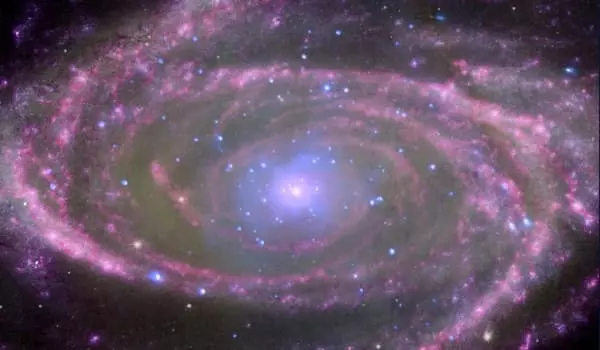Over the last six years, gravitational wave observatories have detected black hole mergers, confirming a major prediction of Albert Einstein’s theory of gravity. However, there is a problem: many of these black holes are unusually large. A team of researchers from the University of Hawaii at Manoa, the University of Chicago, and the University of Michigan at Ann Arbor has proposed a novel solution to this problem: black holes grow in tandem with the expansion of the universe. The study is the first to show that both large and small black hole masses can result from a single pathway, in which black holes gain mass from the expansion of the universe itself.
Since the Laser Interferometer Gravitational-Wave Observatory (LIGO) made the first observation of merging black holes in 2015, astronomers have been astounded by their massive masses. Though they do not emit light, black hole mergers are observed by the emission of gravitational waves, which are ripples in the fabric of spacetime predicted by Einstein’s general theory of relativity. Because merging black holes form from massive stars that can’t hold themselves together if they get too big, physicists originally predicted that black holes would have masses less than about 40 times that of the Sun.
The LIGO and Virgo observatories, on the other hand, have discovered numerous black holes with masses greater than 50 suns, with some as massive as 100 suns. Numerous formation scenarios have been proposed to produce such large black holes, but no single scenario has been able to explain the diversity of black hole mergers observed thus far, and no agreement has been reached on which combination of formation scenarios is physically viable. This new study, published in Astrophysical Journal Letters, is the first to demonstrate that both large and small black hole masses can result from a single pathway, in which black holes gain mass from the expansion of the universe itself.
Many aspects of merging black holes are unknown in detail, such as the dominant formation environments and the intricate physical processes that persist throughout their lives. While we used a simulated stellar population that reflects the data we currently have, there is a lot of wiggle room. We can see that cosmological coupling is a useful concept, but we can’t yet measure the strength of this coupling.
Dr. Michael Zevin
Astronomers typically model black holes within a universe that is incapable of expanding. “It’s an assumption that simplifies Einstein’s equations because a universe that doesn’t grow has a lot less to keep track of,” said Kevin Croker, a professor in the Department of Physics and Astronomy at the University of Hawaii at Manoa. “However, there is a trade-off: predictions may only be accurate for a limited period of time.”
Because the individual events detectable by LIGO — Virgo last only a few seconds, this simplification is appropriate when analyzing any single event. However, these same mergers could take billions of years to complete. The universe expands dramatically between the formation of two black holes and their eventual merger. If the more subtle aspects of Einstein’s theory are carefully considered, a startling possibility emerges: the masses of black holes could grow in lockstep with the universe, a phenomenon known as cosmological coupling by Croker and his colleagues.

Light is the most well-known example of cosmologically coupled material, as it loses energy as the universe expands. “We thought about the inverse effect,” explained research co-author and UH Manoa Physics and Astronomy Professor Duncan Farrah. “What would LIGO Virgo see if black holes were cosmologically coupled and gained energy without consuming other stars or gas?”
The researchers tested this hypothesis by simulating the birth, life, and death of millions of pairs of large stars. Any pairs in which both stars died to form black holes were then linked to the size of the universe, beginning with the time of their deaths. The masses of these black holes grew as the universe expanded, spiraling toward each other. When they merged, the result was not only more massive black holes, but also many more mergers. When the researchers compared the LIGO-Virgo data to their predictions, they found that they agreed fairly well. “I had no idea what to think at first,” said research co-author and University of Michigan Professor Gregory Tarlé. “I was surprised that such a simple idea worked so well.”
This new model is significant, according to the researchers, because it does not require any changes to our current understanding of stellar formation, evolution, or death. The agreement between the new model and our current data stems from the simple recognition that realistic black holes do not exist in a static universe. However, the researchers were quick to point out that the mystery of LIGO — Virgo’s massive black holes is far from solved.
“Many aspects of merging black holes are unknown in detail, such as the dominant formation environments and the intricate physical processes that persist throughout their lives,” said research co-author and NASA Hubble Fellow Dr. Michael Zevin. “While we used a simulated stellar population that reflects the data we currently have, there is a lot of wiggle room.” We can see that cosmological coupling is a useful concept, but we can’t yet measure the strength of this coupling.”
Kurtis Nishimura, research co-author and UH Manoa Physics and Astronomy Professor, expressed optimism for future tests of this novel idea, saying, “As gravitational-wave observatories continue to improve sensitivities over the next decade, the increased quantity and quality of data will enable new analysis techniques.” This will be measured soon enough.”





